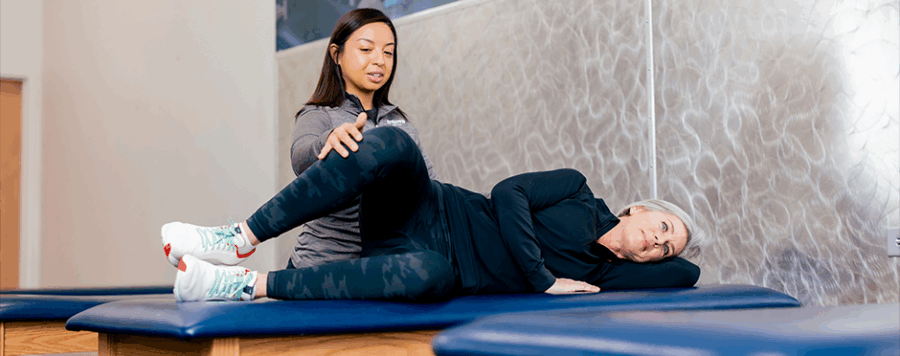1. Mobility
Mobility is a very broad term that can be defined in a variety of ways. One way that it can be used is to define flexibility and range of motion.
Flexibility is the ability something has to change length. In the case of the human body, this would be a muscle, tendon, or ligament. Making sure a muscle is at a normal resting length and has the ability to move is critical to ensure optimal movement patterns. This can be addressed with soft tissue mobilization, dry needling, instrument assisted soft tissue technique, and other approaches.
Range of motion refers specifically to the joint. For example, the hip joint, sacroiliac (SI) joint, and mid and low back, as well as the ankle joints should be assessed. A joint having the ability to move through its full range of motion is essential to performing activities without pain or discomfort.
2. Strength
Strength can also be broken down into sub-categories. Two important aspects are strength and endurance of a muscle.
Strength is important, as this gives the joint or the body part the ability to sustain the demand that is placed on it during activities. Strength is built utilizing 3 – 6 sets of 6 – 12 repetitions. Strength should be performed in all areas the joint is utilized to ensure success with loads it may encounter on a day-to-day basis.
Endurance is also critical, specifically for smaller stabilizing muscles, as they are required to work all day long. Endurance is achieved by doing 3 – 4 sets of 20 – 30 repetitions.
3. Balance
Balance not only helps to prevent falls, but also helps to improve stability of a joint in the place that it is in. This helps the joint to function at an optimal state.
4. Movement Patterns
Ensuring you are moving with proper movement patterns prevents further injury or the potential need for surgery, along with improving function.
Hip Surgery Prevention
To help with differential diagnosis of hip and to improve outcomes for functional independence, Athletico Physical Therapy offers the Hip Preservation Program. Athletico’s Hip Preservation Program can help individuals improve mobility and function to reduce the risk of these injuries and continue recreational and professional activities.
If you are interested in learning more about Athletico’s Hip Preservation Program, including hip arthroscopy risk assessment, please email hip@athletico.com.
Do you have hip pain? Contact Athletico for a free assessment. The Athletico team will take a look at your condition and provide recommendations for the best treatment plan based on your needs and goals.
*Per federal guidelines, beneficiaries of plans such as Medicare, Medicaid, Tricare, VHA and other federally funded plans are not eligible for free assessments.
The Athletico blog is an educational resource written by Athletico employees. Athletico bloggers are licensed professionals who abide by the code of ethics outlined by their respective professional associations. The content published in blog posts represents the opinion of the individual author based on their expertise and experience. The content provided in this blog is for informational purposes only, does not constitute medical advice and should not be relied on for making personal health decisions.
References:
1. Daivajna, S., Bajwa, A., & Villar, R. (n.d.). Outcome of arthroscopy in patients with advanced osteoarthritis of the hip. Retrieved from https://journals.plos.org/plosone/article?id=10.1371/journal.pone.0113970.
2. Hip arthroscopy. (n.d.). Retrieved from https://orthoinfo.aaos.org/en/treatment/hip-arthroscopy/.
3. Hip arthroscopy. (n.d.). Retrieved from https://orthop.washington.edu/patient-care/articles/sports/hip-arthroscopy.html.
4. Kremers, H. M., Schilz, S. R., Houten, H. K. V., Herrin, J., Koenig, K. M., Bozic, K. J., & Berry, D. J. (2017). Trends in utilization and outcomes of hip arthroscopy in the united states between 2005 and 2013. The Journal of Arthroplasty, 32(3), 750–755. doi: 10.1016/j.arth.2016.09.004
5. Pietrzak, J., Donaldson, M., Kayani, B., Rowan, F., & Haddad, F. (2018). Hip arthroscopy: a narrative review of the current literature. Journal of Musculoskeletal Disorders and Treatment, 4(3).
6. Truntzer, J. N., Shapiro, L. M., Hoppe, D. J., Abrams, G. D., & Safran, M. R. (2017). Hip arthroscopy in the united states: an update following coding changes in 2011. Journal of Hip Preservation Surgery, 4(3), 250–257.
7. Vahedi, H., Aalirezaie, A., Azboy, I., Daryoush, T., Shahi, A., & Parvizi, J. (2019, May). Acetabular labral tears are common in asymptomatic contralateral hips with femoroacetabular impingement. Retrieved from https://www.ncbi.nlm.nih.gov/pubmed/30444756.
8. Young, J. L., Wright, A. A., & Rhon, D. I. (2019). Nonoperative management prior to hip arthroscopy for femoroacetabular impingement syndrome: an investigation into the utilization and content of physical therapy. Journal of Orthopaedic & Sports Physical Therapy, 49(8), 593–600. doi: 10.2519/jospt.2019.8581
9. Bonazza, N. A., Homcha, B., Liu, G., Leslie, D. L., & Dhawan, A. (2018). Surgical trends in arthroscopic hip surgery using a large national database. Arthroscopy: The Journal of Arthroscopic & Related Surgery, 34(6), 1825–1830. https://doi.org/10.1016/j.arthro.2018.01.022
About the Author:
Paige Gibbens is a physical therapist specializing in lower extremity treatments and is certified in dry needling and Graston. She is also the Missouri & Southern Illinois regional coordinator for Athletico's Endurance Program.

 width="900"
height="356"
>
width="900"
height="356"
>

1 Comment
Annette Culbert
Right hip popping